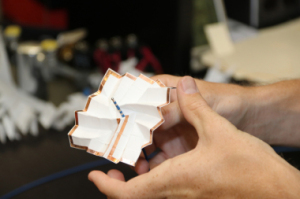by
Christina Hwang, Contributing Reporter | August 09, 2016
Thanks, in part, to the ancient Japanese folding art of origami, physicians who depend on smart physiological sensing and imaging to guide catheter ablation may soon be able to perform the procedure in a more accurate and efficient way than ever before.
Supported by a $5,000 award from the American Society for Quality to support his research, Austin Taylor, a graduate student at the University of Georgia, joined up with Dr. Zion Tse, assistant professor of the Medical Robotics Laboratory at UGA, to develop a prototype device that combines smart physiological sensors and ablation in the same catheter.
When in a folded state, the device resembles a pinwheel on the tip of the catheter. Unfolded, it opens into a thin, flat sheet that holds physiological sensors inside the heart.



Ad Statistics
Times Displayed: 365841
Times Visited: 7102 Quality remanufactured Certified Centrifuges at Great prices! Fully warranted and backed by a company you can trust! Call or click for a free quote today! www.Centrifugestore.com 800-457-7576
With the sensors directly inside the patient, physiological data of the inside of the heart is captured to inform the surgery in progress.
“This is a rather elegant mechanical engineering solution for a challenging clinical problem in interventional cardiology,” Tse told HCB News. “The origami principle allows mechanical structures to be closed tightly and to be deployed in a large and desirable surface area, which are important features required in cardiovascular devices.”
In the following image, the origami structure is depicted at 0 percent, 30 percent, 70 percent, and 100 percent of its deployed state.
The American Society of Mechanical Engineers
According to The
Journal of Medical Devices, in which the researchers published a description of the origami catheter, the tool builds upon the benefits of an older smart-sensing catheter model where the deployable structure collapses and expands to deploy sensors inside the heart.
The new smart sensing catheter utilizes a low-cost disposable design so it doesn’t require sterilization after use.
“This minimally invasive procedure reduces the risk of large blood loss and prolonged hospitalization time, as well as the associated medical costs,” said Tse.
As of now, the design is still in the prototyping stage and needs further development and preclinical trials before it can be used in real-life situations. Once the device is ready, Taylor and Tse hope to file a patent for the catheter and reach out to a medical device company to help them manufacture it.
Tse said that this is not the first time smart physiological sensors have been inserted into a patient’s body. He said that transrectal MR prostate imaging, for example, has shown promise in enhancing a radiologist’s visualization of cancer and lesion structures.

